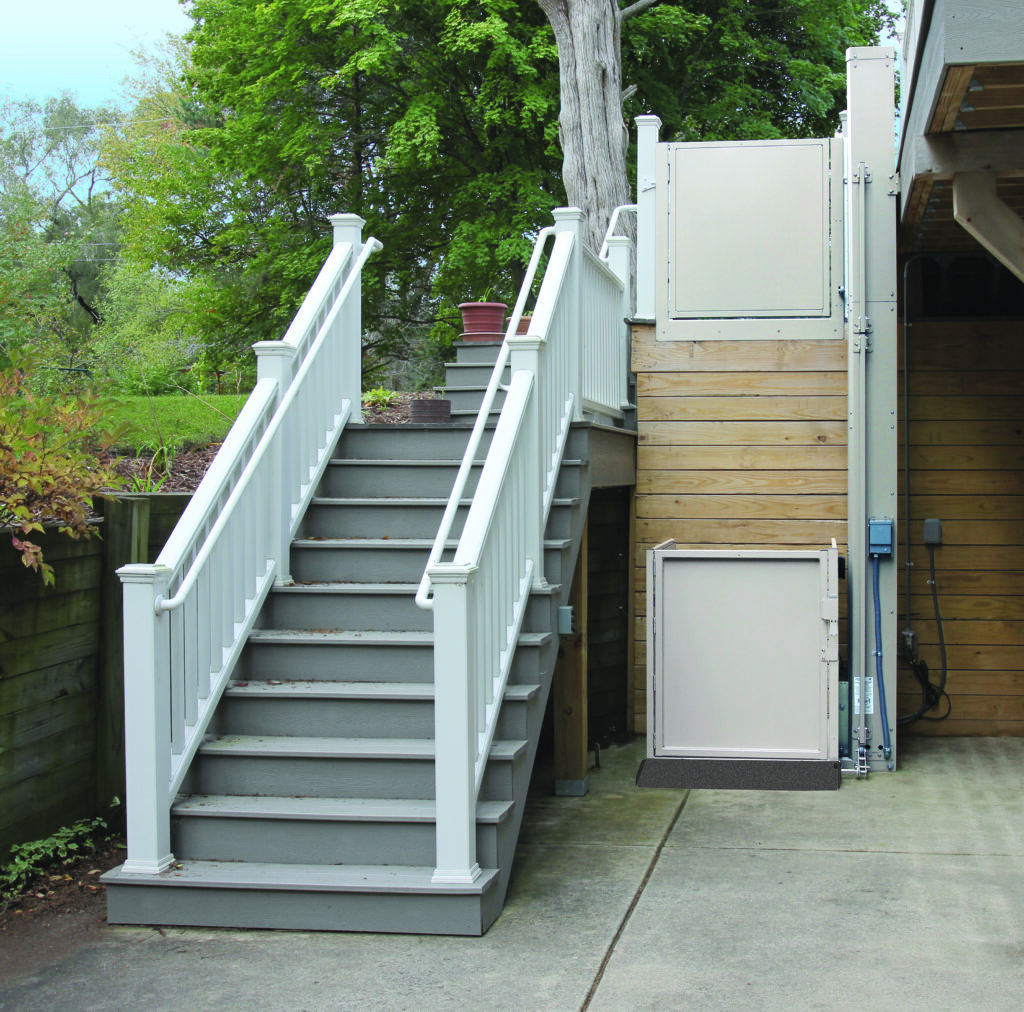
Wheelchair lifts are an ideal solution to allow people with limited mobility to independently navigate stairs in homes and public buildings. They are more space efficient than wheelchair ramps, more affordable than home elevators, and more suitable for wheelchair users than stair lifts. Wheelchair lifts can transport people who use wheelchairs, scooters, and powerchairs without them ever having to leave their chairs. You can take a critical step towards enhancing accessibility with the installation of a wheelchair lift.
Choosing the Right Wheelchair Lift
Many homeowners do not have enough space around the entrances of their home or their garages to install a safe, ADA-compliant ramp for wheelchair users and others with limited mobility. Installing a short, steep ramp is not safe or practical, but wheelchair lifts can provide a solution for homes with space constraints.
Wheelchair lifts, also known as vertical platform lifts (VPLs), are highly space efficient, and they can accommodate any scooter, powerchair, or wheelchair. They can be installed inside or outside, with heights up to 14 feet, weather-resistant controls, and specialized coatings.
Pre-Installation Considerations
The first step is to inspect and prepare the site. Lifts must be supported either with a concrete base or adequately supported walls. For vertical platform lift installation, a shaftway or hoistway must be constructed. The unit needs to be secured to a support wall with 2 x 4 or 2 x 6 framing, and a pit must be constructed underneath. A lift requires 110-volt power and a phone line.
Wheelchair Platform Lift Door Requirements
Accessibility codes must be followed when installing doors on a wheelchair lift, and manufacturers will provide doors that meet local code requirements.
Special swing doors must be flush mounted (flush mounting eliminates pinching hazards):
- In a public setting
- When the VPL is in a hoistway
- At all landings
Doors must be automatic/power-operated:
- If the car is entered at two landings on the same side
- If the car is entered on one end and exited 90 degrees from that
- If an entrance is accessed with a ramp
- In an application with more than two stops
- When doors do not have 18” of clearance next to the handle side of the door
Installation Process for Wheelchair Lifts
Indoor wheelchair lift installation process:
- A shaftway or hoistway must be constructed.
- The unit will be secured to a support wall with 2 x 4 or 2 x 6 framing.
- A pit must be constructed.
- The electrical must include a disconnect switch.
Outdoor wheelchair lift installation process:
- The lift is securely fastened at the base, usually with a concrete pad under the lift.
- The lift is assembled on-site, including the installation of the gate(s).
- The unit will be powered and tested.
The installation process, excluding site preparations, typically takes at least one day.
Maintenance & Warranty Information
Well-maintained wheelchair lifts will serve you for many years. The required regular maintenance schedule can be found in the owner’s manual that will be provided when you purchase your lift. Like any mechanical vehicle, the parts of a wheelchair lift need to be lubricated and adjusted from time to time. Some parts may also need to be replaced over time.
Manufacturers offer warranties with different periods and maintenance is typically required to keep your coverage valid. Wheelchair lift dealers offer labor warranties as well, and many offer prepaid maintenance contracts to ensure you are covered for years to come. Be sure to ask about manufacturer warranties, labor warranties, and dealer service contracts before purchasing a lift.
Most manufacturers require any warranty repairs to be done by an authorized dealer as they have specialized training to service your specific lift. Be sure to purchase from a reputable company.
FAQs About Wheelchair Installation
Can a Wheelchair Lift be Operated Independently?
All of our wheelchair lifts are configured for independent operation. All the vertical platform lifts can be operated by an attendant from any of the control panel locations if the user is unable to operate the push buttons or prefers that the lift be operated by others.
Is a Wheelchair Lift Difficult to Use?
Stop by our Illinois showroom and take one of our wheelchair lifts for a spin! They are designed with users and caregivers in mind and are easy to operate. Simply call us to set up an appointment.
How High Can a Wheelchair Lift Go?
Wheelchair lifts can travel up to 14 vertical feet from the lower finished floor to the upper landing.
What Is the Weight Limit of a Wheelchair Lift?
Weight capacity is limited by code with most vertical wheelchair lift models rated for 750 lbs.
How Big of a Platform Size Can I Get?
Accessibility codes limit the maximum size to 18 sq ft. Standard model sizes start at approximately 36” wide x 54” long, although many other optional sizes are available to best fit your application’s needs.
Contact DME Elevators & Lifts for Wheelchair Lift Installation
If you’re considering installing a wheelchair lift in your home or business, you should discuss your mobility needs with an experienced lift dealer.
DME Elevators & Lifts has been providing Excellence in Elevation since 1977, and our in-house wheelchair lift installers are highly trained for top-notch installation and service.
We offer indoor wheelchair lifts, outdoor wheelchair lifts, and other mobility products to make life more accessible. Contact us to start with an on-site assessment of your space.







